Introduction
The importance of efficient storage solutions in businesses
Effective storage solutions are essential for businesses of all sizes. Proper organization and storage can significantly impact productivity, safety, and overall operational efficiency. By optimizing storage space, businesses can streamline their workflows, reduce clutter, and ensure quick access to essential items. This not only enhances the work environment but also contributes to cost savings by minimizing the time spent searching for materials and reducing the risk of damage to stored items.
Purpose of the Article
The purpose of this article is to guide businesses in choosing the right boltless shelving system. By understanding the key factors to consider, businesses can make informed decisions that enhance their storage efficiency and meet their specific needs. Whether you are setting up a new storage area or upgrading an existing one, this guide will provide valuable insights to help you select the most suitable boltless shelving for your business.
1.Understanding Boltless Shelving
1.1 Definition and Basic Structure
Boltless shelving, also called rivet shelving, is a storage system that can be assembled without using nuts, bolts, or screws. Instead, it employs interlocking components like rivets, keyhole slots, and shelf beams that fit together. This design enables fast and straightforward assembly, often needing just a rubber mallet as the only tool. The basic structure includes vertical posts with keyhole slots and horizontal beams that lock into these slots, creating a sturdy and customizable shelving unit.
1.2 Types of Boltless Shelving
Different types of boltless shelving cater to various storage needs and offer distinct features and load capacities. Here’s a summary of the primary types:
1) Boltless rivet Shelving
– Structure: Features vertical angle posts with keyhole slots every 1.5 inches, allowing for easy height adjustments of the shelves.
– Load Capacity: Typically ranges from 385 to 1000 pounds per shelf.
– Accessibility: Offers access from all sides, with no crossbars obstructing the view.
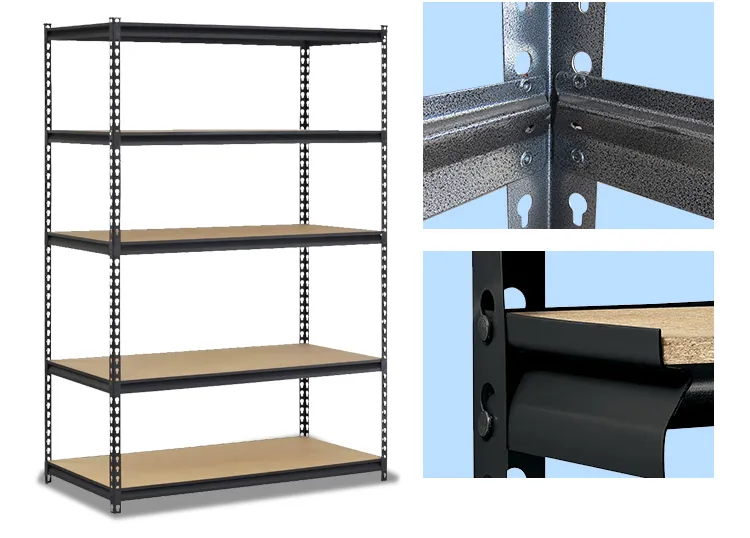
2) Boltless slotted shelving
– Structure: Features columns with slots, with two tips at each end of the beam. To assemble, insert the tips at both ends of the beam into the slots on the columns and tap them tightly with a rubber hammer.
– Load Capacity: Typically ranges from 385 to 660 pounds per shelf.
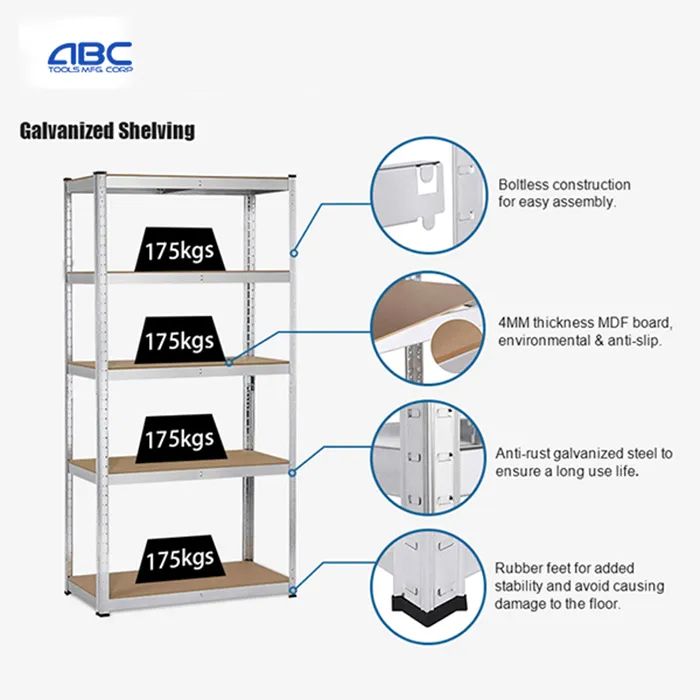
3) Low Profile Shelving
– Structure: Uses a single rivet design for a lower profile, making it easier to access items.
– Load Capacity: Generally supports around 250 pounds per level.
– Use Case: Suitable for environments where space is limited and items need to be easily accessible.
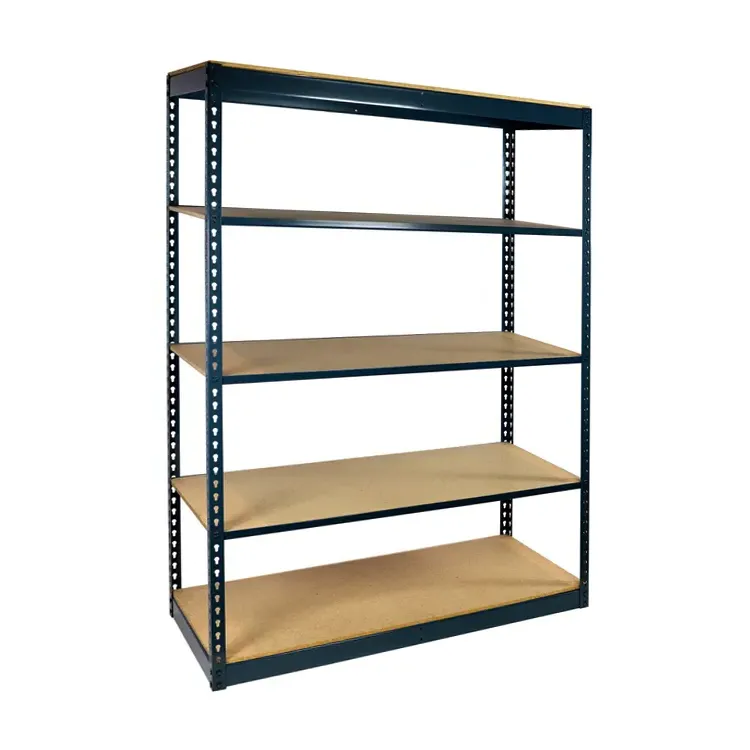
4) Longspan Welded Steel Boltless Shelving
– Structure: Features double rows of holes on its columns, allowing for infinite expansion. The welded steel construction provides additional strength and durability.
– Load Capacity: Designed for bulk storage of larger and heavier items, generally supports around 250 pounds per level.
– Use Case: Commonly used in warehouses, distribution centers, and manufacturing plants for storing heavy and bulky items.
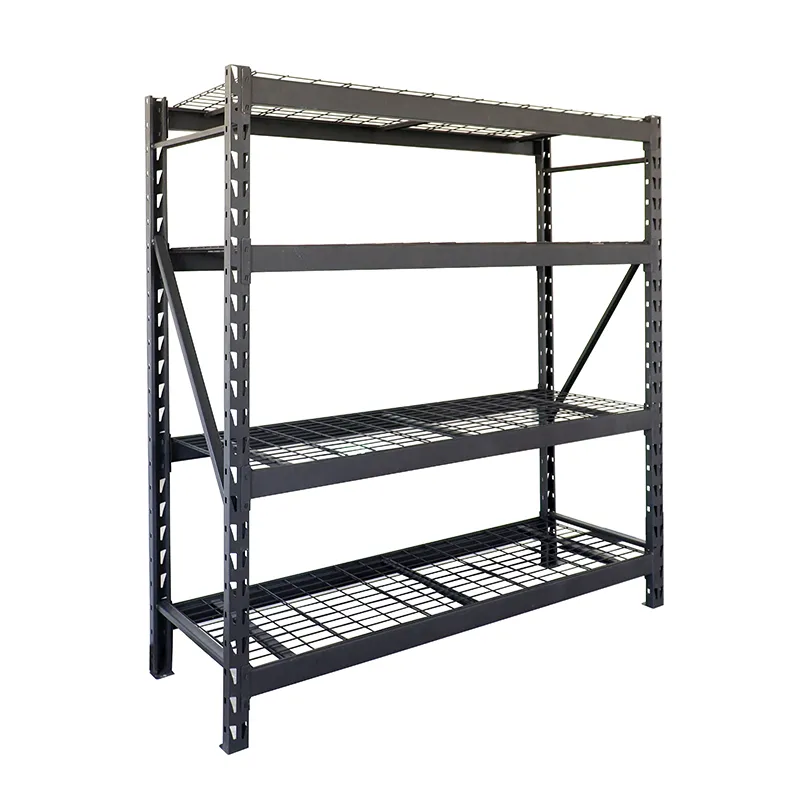
5) Wire Shelving
– Structure: Made with wire decks that provide better airflow and visibility for stored items.
– Load Capacity: Generally ranges from 300 to 800 pounds per shelf, depending on design and materials.
– Use Case: Ideal for environments requiring ventilation, such as food storage or retail displays.
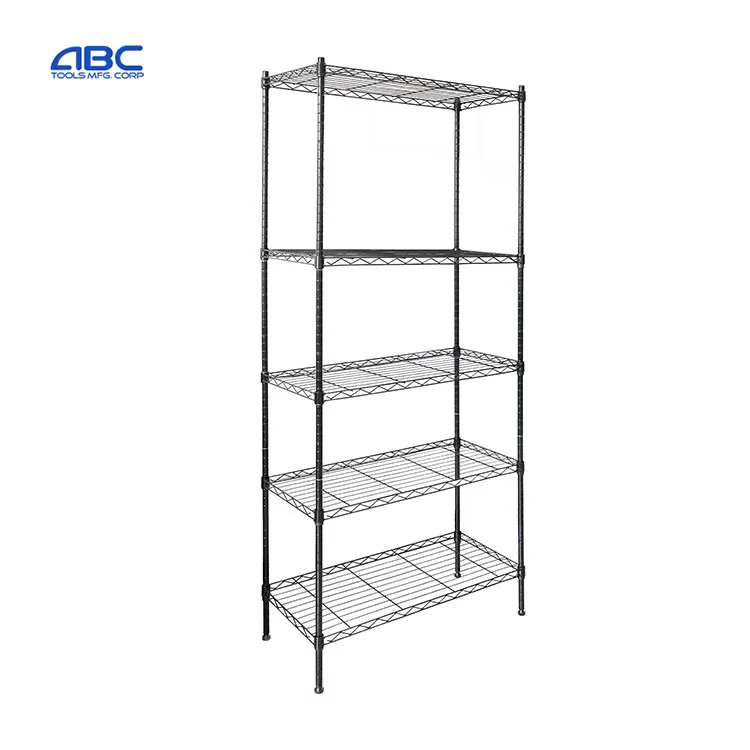
6) Plastic Shelving
– Structure: Constructed from high-density plastic, making it lightweight and resistant to corrosion.
– Load Capacity: Typically supports between 50 to 250 pounds per shelf.
– Use Case: Best suited for environments where moisture is a concern, such as basements or outdoor storage.
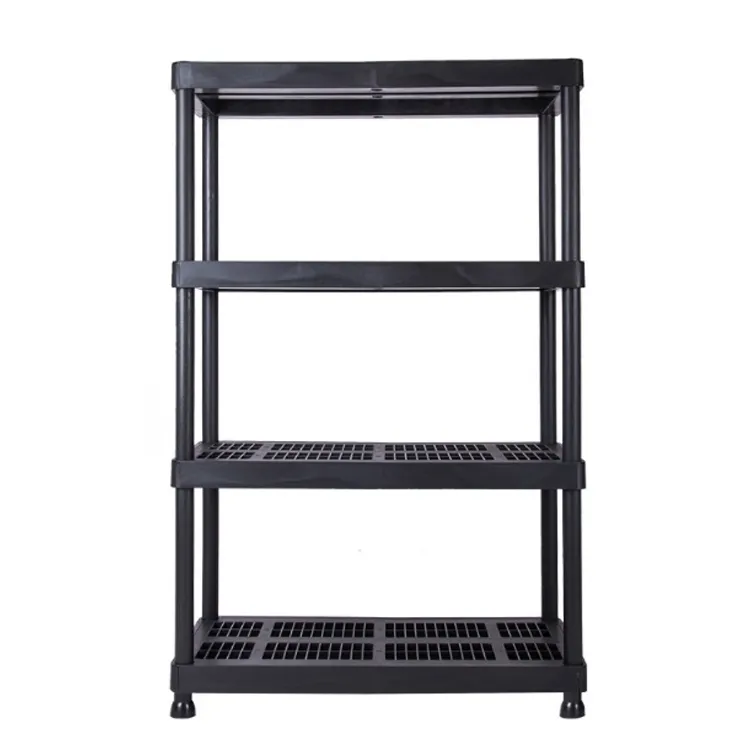
These various types of boltless shelving provide flexible and efficient storage solutions tailored to different needs, ensuring that you can find the right option for your specific storage requirements.
1.3 Key Advantages
Boltless shelving systems offer several key advantages:
– Easy Assembly: The interlocking design allows for quick and tool-less assembly, often requiring only a rubber mallet. This ease of assembly makes it a convenient option for both commercial and residential use.
– Durability: Typically made from high-quality steel, boltless shelving units are capable of supporting heavy loads and are resistant to wear and tear. This makes them ideal for long-term use in demanding environments.
– Cost-Effectiveness: Boltless shelving systems are generally more affordable than traditional shelving systems. Their durability and low maintenance needs further enhance their cost-effectiveness.
– Versatility and Customizability: Boltless shelving can be easily adjusted and reconfigured to meet changing storage needs. The open design allows for access from all sides, and shelves can be positioned at various heights to accommodate different item sizes.
– Space Optimization: The design of boltless shelving allows for efficient use of space, maximizing storage capacity without wasting room on unnecessary components.
In summary, boltless shelving is a versatile, durable, and cost-effective storage solution suitable for a wide range of applications, from industrial warehouses to home garages. Its easy assembly and adaptability make it a popular choice for those looking to optimize their storage spaces efficiently.
2. Assessing Your Storage Needs
When planning to implement a boltless shelving system, it’s crucial to thoroughly assess your storage needs. This assessment will help you choose the most appropriate shelving type and configuration for your specific requirements. Here’s a detailed look at the key factors to consider:
2.1 Identifying What You Need to Store
1) Weight Considerations:
– Determine the weight of individual items you plan to store.
– Calculate the total weight capacity needed for each shelf.
– Consider the overall weight distribution across the entire shelving unit.
2) Size Considerations:
– Measure the dimensions (length, width, height) of the largest items you’ll be storing.
– Account for any oddly shaped items that may require special accommodation.
– Consider the vertical space between shelves needed for easy access and visibility.
3) Quantity Considerations:
– Estimate the total number of items you need to store.
– Factor in potential growth or seasonal fluctuations in inventory.
– Consider whether you need to store items in bulk or individually.
2.2 Considering the Type of Items
1) Boxes and Containers:
– Determine the standard sizes of boxes or containers you use.
– Consider whether you need easy access to all sides of the boxes.
– Think about labeling and organization systems for boxed items.
2) Tools and Equipment:
– Assess if you need specialized storage for certain tools (e.g., hanging racks for long-handled tools).
– Consider the need for drawer units or bins for smaller tools and parts.
– Think about the frequency of access to different tools.
3) Inventory and Products:
– Consider the turnover rate of your inventory.
– Assess if you need a first-in-first-out (FIFO) system for perishable goods.
– Think about grouping similar products together for efficient order picking.
4) Fragile or Sensitive Items:
– Determine if you need special padding or protective measures for delicate items.
– Consider climate-controlled options for temperature-sensitive goods.
2.3 Space Availability and Layout Considerations
1) Available Floor Space:
– Assess the total floor area available for shelving.
– Consider any obstructions like pillars, doors, or windows.
– Think about the aisle width needed for easy movement and access.
2) Ceiling Height:
– Measure the ceiling height to determine the maximum vertical storage potential.
– Consider any overhead obstructions like light fixtures or sprinkler systems.
3) Layout Efficiency:
– Plan for efficient traffic flow around the shelving units.
– Consider the proximity to loading areas or workstations.
– Think about future expansion possibilities.
4) Safety and Accessibility:
– Ensure there’s adequate lighting for all storage areas.
– Plan for easy access to fire extinguishers and emergency exits.
– Consider the need for ladders or lifting equipment for higher shelves.
5) Environmental Factors:
– Assess if the storage area is prone to moisture, heat, or cold.
– Consider ventilation needs, especially for storing certain types of goods.
By thoroughly assessing these factors, you’ll be better equipped to choose the right boltless shelving system that meets your specific storage needs, maximizes your available space, and ensures the efficient organization of your items. This assessment will also help you avoid common pitfalls such as underestimating weight capacity needs or choosing shelving that doesn’t fit your space constraints.
3. Evaluating Load Capacity
3.1 Importance of Load-Bearing Capacity
Load-bearing capacity is crucial for boltless shelving systems for several reasons:
– Safety: Ensures the shelving can safely support stored items without risk of collapse or failure.
– Durability: Proper load capacity prevents damage to the shelving structure over time.
– Efficiency: Allows for optimal use of storage space by accommodating maximum weight.
– Compliance: Meets safety standards and regulations for storage systems.
3.2 Calculating Required Load Capacity
To determine the load capacity needed for your shelving:
1. Identify the heaviest items to be stored
2. Weigh or estimate the total weight of all items per shelf
3. Add a safety factor (typically 15-25%) to account for unexpected loads
4. Consider dynamic loads from movement or vibration
5. Factor in the shelving material and design limitations
The basic formula is:
Required Load Capacity = (Weight of Items + Safety Factor) x Number of Shelves
3.3 Examples of Load Capacity for Boltless Shelving Types
Different types of boltless shelving offer varying load capacities:
– Boltless Rivet Shelving: Typically 385-1000 pounds per shelf
– Boltless Slotted Shelving: Can support 385-660 pounds per shelf
– Low Profile Shelving: Supports around 250 pounds per shelf.
– Longspan Welded Steel Boltless Shelving: Around 2000 pounds per shelf
– Wire Shelving: 300-800 pounds per shelf, depending on design
– Plastic Shelving: Usually 50-250 pounds per shelf, depending on material and construction
It’s important to note that these are general ranges, and specific load capacities can vary by manufacturer and model. Always consult the manufacturer’s specifications for accurate load ratings.
When evaluating load capacity, consider not just the weight per shelf, but also the total weight capacity of the entire unit. Ensure the flooring can support the fully loaded shelving system as well.
By carefully assessing your storage needs and choosing shelving with appropriate load capacity, you can create a safe, efficient, and durable storage solution.
4. Material and Durability
4.1 Common Materials Used in Boltless Shelving
Boltless shelving systems are constructed from various materials, each offering unique benefits and drawbacks. Here are the most common materials:
1)Steel
2)Aluminum
3)Particle Board
4)Wire Mesh
5)Plastic
4.2 Pros and Cons of Each Material
1) Steel
– Pros:
– Durability: Highly durable and capable of supporting heavy loads.
– Strength: Excellent load-bearing capacity, suitable for industrial use.
– Resistance: Resistant to impacts and wear.
– Cons:
– Weight: Heavier than other materials, making it more challenging to move.
– Cost: Typically higher than other materials.
2) Aluminum
– Pros:
– Lightweight: Simpler to handle and relocate than steel.
– Corrosion Resistance: Inherently resistant to rust and corrosion.
– Cons:
– Strength: Not as strong as steel, with lower load-bearing capacity.
– Cost: Can be more expensive than steel, depending on the application.
3) Particle Board
– Pros:
– Cost-Effective: Generally cheaper than metal options.
– Smooth Surface: Ideal for storing items that require a flat, smooth surface.
– Cons:
– Durability: Less durable and can degrade over time, especially in moist conditions.
– Fire Risk: Flammable and can close off access to sprinkler systems.
4) Wire Mesh
– Pros:
– Ventilation: Allows for better airflow and visibility.
– Cleanliness: Simplifies cleaning and reduces dust buildup.
– Cons:
– Cost: Often more expensive than particle board.
– Load Capacity: This may not support as much weight as solid shelves.
5) Plastic
– Pros:
– Lightweight: Convenient to move and manage.
– Corrosion Resistance: Extremely resistant to moisture and chemicals.
– Cons:
– Strength: Generally supports lower weights compared to metal.
– Durability: Can be less durable over time, especially under heavy loads.
4.3 Considerations for Durability and Longevity
When selecting boltless shelving, consider the following factors to ensure durability and longevity:
1) Material Quality: Choose high-quality materials from reputable manufacturers to ensure long-lasting performance.
2) Load Capacity: Ensure the shelving can support the intended load without sagging or warping.
3) Environmental Conditions: Consider the environment where the shelving will be used. For example, steel or aluminum is better for humid or corrosive environments, while plastic is ideal for areas prone to moisture.
4) Maintenance: Conduct regular inspections and upkeep to address any signs of wear and tear.This includes tightening connections, cleaning, and replacing damaged components.
5) Proper Assembly: Follow the manufacturer’s instructions for assembly to ensure stability and safety.
6) Usage Guidelines: Adhere to the recommended load limits and usage guidelines to prevent overloading and potential damage.
By carefully considering the material and its properties, you can select the most suitable boltless shelving for your needs, ensuring durability and longevity in your storage solution.
5. Customization and Flexibility
5.1 Importance of Adjustable Shelving
Adjustable shelving is a critical feature in modern storage solutions, providing significant benefits:
– Versatility: Adjustable shelving allows users to modify shelf heights and spacing, accommodating items of various sizes and shapes. This adaptability is particularly valuable for changing storage needs over time.
– Maximized Space: By adjusting shelf heights, users can optimize vertical space and make the most of available storage areas, which is essential in smaller or cluttered environments.
– Enhanced Accessibility: Adjustable systems ensure that items are easily reachable, reducing the need to sift through cluttered shelves to find specific items.
5.2 Customization Options
Boltless shelving systems offer a range of customization options, including:
– Shelf Heights: Users can easily adjust the height of each shelf to fit different items, whether they are tall boxes, small tools, or bulky equipment. This feature is often achieved through a system of slots or holes along the sides of the shelving unit.
– Material Choices: Customization can also extend to the materials used for shelving, allowing users to choose options that best fit their aesthetic preferences and functional requirements.
5.3 Flexibility for Future Storage Needs and Expansions
One of the most significant advantages of adjustable shelving is its inherent flexibility:
– Adaptability: As storage needs change(whether due to seasonal inventory fluctuations, new product lines, or changes in personal belongings) adjustable shelving can be reconfigured to meet these evolving requirements without the need for complete replacement.
– Future Expansion: Many shelving systems are designed to be easily expanded. Users can add more shelves or units as needed, allowing for scalable storage solutions that grow with changing demands.
– Cost-Effectiveness: Investing in adjustable shelving can be more cost-effective in the long run. Instead of purchasing new shelving units as needs change, users can simply adjust existing units, saving money and reducing waste.
Based on the search results and the query, here’s an overview of the ease of assembly and maintenance for boltless shelving:
6. Ease of Assembly and Maintenance
6.1 Factors Affecting the Ease of Assembly
1) Effortless Assembly: Boltless shelving features a design that allows for quick and straightforward setup without requiring nuts, bolts, or other fasteners.
2) Minimal Tools Required: Often, only a rubber mallet is needed for assembly.
3) Interlocking Components: The system uses interlocking parts like rivets, keyhole slots, and shelf beams that slide into place.
4) Clear Instructions: Most manufacturers provide detailed assembly instructions.
5) Modular Design: Components are typically designed to fit together easily in a logical sequence.
6.2 Maintenance Requirements for Different Types of Shelving
1) Steel Shelving:
– Regular dusting and cleaning
– Periodic checks for rust or corrosion, especially in humid environments
– Tightening of any loose components
2) Wire Shelving:
– The open design facilitates easy cleaning.
– Less prone to dust accumulation
– May require occasional realignment of wire components
3) Plastic Shelving:
– Can be easily cleaned with soap and water.
– Resistant to moisture and chemicals, requiring less maintenance
– May need periodic checks for cracks or warping
4) Particle Board Shelving:
– More susceptible to moisture damage, requiring careful cleaning
– May need replacement more frequently than metal options
– Regular checks for sagging or warping
6.3 Tips for Easy Assembly and Maintenance
1) Read Instructions Carefully: Before starting assembly, thoroughly review the manufacturer’s instructions.
2) Prepare the Area: Ensure you have enough space to lay out all components before assembly.
3) Check Components: Verify that all necessary parts are present before beginning assembly.
4) Use Proper Tools: While minimal tools are needed, ensure you have a rubber mallet on hand.
5) Start with a Level Surface: Ensure the floor is level for proper alignment of the shelving unit.
6) Regular Inspections: Conduct periodic checks for loose components, wear, or damage.
7) Clean Regularly: Maintain cleanliness to prevent buildup of dust or debris that could affect performance.
8) Avoid Overloading: Adhere to the manufacturer’s weight capacity guidelines to prevent damage and ensure longevity.
9) Address Issues Promptly: If any damage or wear is noticed, address it immediately to prevent further issues.
10) Keep Assembly Instructions: Retain the assembly instructions for future reference or reconfiguration needs.
By following these guidelines, you can ensure that your boltless shelving is assembled correctly and maintained properly, leading to a longer lifespan and better performance of your storage system.
7. Budget Considerations
When investing in boltless shelving, it’s crucial to balance immediate costs with long-term value. Here’s a comprehensive look at budget considerations:
7.1 Balancing Quality and Cost
1) Initial Investment vs. Long-term Value
– Higher quality shelving often comes with a higher price tag but can offer better durability and longevity.
– Consider the total cost of ownership, including potential replacement costs for cheaper options.
2) Material Choices
– Steel: Generally more expensive but offers superior strength and durability.
– Aluminum: Lighter and corrosion-resistant, but often pricier than steel.
– Particle Board: Cost-effective but less durable, especially in humid environments.
– Plastic: Affordable and moisture-resistant, but may have lower weight capacities.
3) Load Capacity Requirements
– Higher load capacities typically correlate with higher costs.
– Assess your actual needs to avoid overpaying for unnecessary capacity.
4) Brand Reputation
– Well-known brands may be more expensive but often offer better quality and customer support.
– Lesser-known brands might offer competitive pricing but verify their quality and reliability.
7.2 Long-term Cost Savings with Durable Shelving
1) Reduced Replacement Frequency
– High-quality shelving lasts longer, reducing the need for frequent replacements.
– This can lead to significant savings over time, especially in high-use environments.
2) Maintenance Costs
– Durable shelving often requires less maintenance, reducing ongoing costs.
– Consider the ease of cleaning and resistance to wear and tear.
3) Flexibility and Adaptability
– Modular systems that allow for reconfiguration can adapt to changing needs without requiring full replacement.
– This adaptability can lead to cost savings as your storage requirements evolve.
4) Safety Considerations
– Investing in sturdy, reliable shelving can reduce the risk of accidents and potential liability costs.
5) Efficiency Improvements
– Well-designed shelving can improve operational efficiency, indirectly saving costs through improved productivity.
7.3 Comparing Prices and Value from Different Suppliers
1) Request Multiple Quotes
– Obtain quotes from multiple suppliers to find the best prices.
– Ensure quotes include all necessary components and any additional fees.
2) Look Beyond the Price Tag
– Consider factors such as warranty, customer service, and installation support.
– Consider the reputation and reliability of the supplier.
3) Volume Discounts
– If you need a large quantity, inquire about bulk purchase discounts.
– Some suppliers may offer better rates for long-term contracts or repeat business.
4) Customization Costs
– Factor in any costs for customization or special features you might need.
– Sometimes, a slightly more expensive standard option might be more cost-effective than a heavily customized cheaper alternative.
5) Shipping and Installation Costs
– Include these in your cost comparisons, as they can significantly impact the total price.
– Some suppliers might offer free shipping or installation for large orders.
6) Total Solution Cost
– Consider the cost of the entire storage solution, not just individual components.
– A supplier offering a comprehensive package might provide better overall value.
7) Financing Options
– Some suppliers offer financing plans which might make higher-quality options more accessible.
– Compare the long-term costs of financing versus upfront purchase.
8) Return Policies and Guarantees
– Evaluate the flexibility of return policies and the strength of product guarantees.
– These can provide added value and reduce risk in your purchase.
By carefully considering these budget factors, you can make an informed decision that balances immediate costs with long-term value, ensuring that your investment in boltless shelving meets both your current needs and future requirements while staying within your budget constraints.
8. Safety and Compliance
8.1 Safety Features to Look for in Boltless Shelving
Ensuring the safety of boltless shelving systems is paramount, especially in industrial and commercial settings. Here are key safety features to consider:
1) Anti-Tip Brackets
– Prevents accidental tipping of the shelving unit, ensuring stability and safety for employees and stored items.
2) Reinforced Beams
– Integrated weight distribution channels and reinforced beams enhance the strength and stability of the shelving units, reducing the risk of collapse.
3) Clear Weight Capacity Labels
– Clearly marked weight capacities help avoid overloading shelves, maintaining structural integrity and safety.
4) Secure Interlocking Design
– The absence of bolts reduces protruding parts that could pose hazards, and the interlocking mechanism ensures a secure and stable assembly.
5) Adjustable Shelf Heights
– Allows for customization to meet specific storage needs, ensuring that heavy items are stored at appropriate heights to prevent accidents.
8.2 Importance of Secure and Stable Shelving Systems
Secure and stable shelving systems are essential for several reasons:
1) Employee Safety
– Prevents accidents and injuries caused by collapsing shelves or falling items, ensuring a safe working environment.
2) Product Protection
– Minimizes the risk of damage to stored items, preserving inventory integrity and reducing losses.
3) Operational Efficiency
– Stable shelving systems facilitate efficient organization and retrieval of items, improving workflow and productivity.
4) Compliance and Liability
– Ensuring that shelving systems meet safety standards helps avoid legal issues and potential liabilities associated with workplace accidents.
8.3 Tips for Ensuring Safety and Compliance
1) Regular Inspections
– Conduct periodic inspections to check for signs of wear, damage, or overloading. Address problems immediately to ensure safety is maintained.
2) Proper Installation
– Follow the manufacturer’s instructions for assembly and installation to ensure the shelving is secure and stable.
3) Training
– Train employees on the proper use and maintenance of shelving systems, including weight limits and safe loading practices.
4) Load Distribution
– Distribute weight evenly across shelves and avoid overloading any single shelf to maintain stability.
5) Use of Safety Accessories
– Utilize safety accessories such as anti-tip brackets and clear weight capacity labels to enhance the safety of the shelving system.
By prioritizing safety features and ensuring secure and stable shelving systems, you can create a safe and efficient storage environment that protects both employees and inventory.
9. Vendor Selection
Choosing the right vendor for your boltless shelving needs is crucial to ensure quality, reliability, and cost-effectiveness. Here are key considerations for selecting a reliable vendor:
9.1 Criteria for Choosing a Reliable Vendor
1) Quality of Products
– Ensure the vendor provides high-quality shelving systems that meet your durability and load capacity requirements.
2) Pricing and Value
– Look for competitive pricing, but focus on getting the best value for your money. Avoid vendors with prices significantly lower than the market average, as this may indicate lower quality.
3) Reputation and Track Record
– Investigate the vendor’s reputation via online reviews, testimonials, and references. A good track record indicates reliability and customer satisfaction.
4) Financial Stability
– Assess the financial health of the vendor to ensure they can fulfill long-term contracts and scale up if needed.
5) Delivery and Lead Times
– Evaluate the vendor’s ability to meet delivery schedules and their flexibility in handling changes in order volume.
6) Customer Service
– Consider the quality of customer service, including responsiveness, problem resolution, and after-sales support.
7) Compliance and Certifications
– Ensure the vendor complies with industry standards and holds relevant certifications, which can be a mark of quality and reliability.
8) Customization Options
– Check if the vendor offers customization options to meet specific storage needs, such as adjustable shelf heights and additional components.
9.2 Questions to Ask Potential Suppliers
1) Can you provide references from previous clients?
– This helps verify the vendor’s reliability and quality of service.
2) What is your average lead time for orders?
– Understanding delivery timelines ensures they can meet your scheduling needs.
3) Do you offer any warranties or guarantees on your products?
– Warranties offer confidence in the product’s quality and the vendor’s commitment.
4) What are your payment terms and conditions?
– Clarify payment schedules, penalties for late payments, and any discounts for early payments.
5) How do you handle product returns or defective items?
– Knowing their return policy helps manage risks associated with defective products.
6)Can you provide a detailed itemization of the costs?
– Confirm that all costs are clear to avoid unexpected charges.
7) What customization options do you offer?
– This is crucial if you have specific requirements for your shelving system.
8) How do you ensure compliance with industry standards?
– Compliance with standards ensures product safety and reliability.
9.3 Importance of Customer Reviews and Testimonials
1) Insight into Vendor Performance
– Reviews and testimonials provide real-world insights into the vendor’s performance, reliability, and customer satisfaction.
2) Verification of Claims
– Customer feedback can help verify the vendor’s claims about product quality, delivery times, and customer service.
3) Identifying Potential Issues
– Negative reviews can highlight potential issues or red flags, such as poor quality or unreliable delivery.
4) Building Trust
– Positive testimonials can build trust and confidence in the vendor’s ability to meet your needs.
Selecting the right vendor for boltless shelving involves careful consideration of multiple factors, including product quality, pricing, reputation, and customer service. By asking the right questions and reviewing customer feedback, you can make an informed decision that balances cost with long-term value and reliability. This approach ensures you partner with a vendor who can meet your current and future storage needs effectively.
Conclusion
In summary, selecting the right boltless shelving system is a critical decision that can significantly impact your storage efficiency and overall business operations. Here’s a summary of the important points to keep in mind:
Recap of Key Points to Consider
1) Understanding Your Storage Need: Assess the weight, size, and quantity of items you need to store, as well as the types of items and available space.
2) Evaluating Load Capacity: Ensure that the shelving you choose can support the intended weight and is designed for the specific items you plan to store.
3) Material and Durability: Consider the materials used in shelving construction, weighing the pros and cons of each to find the best fit for your environment.
4) Customization and Flexibility: Look for adjustable shelving options that can adapt to changing storage needs and allow for future expansions.
5) Ease of Assembly and Maintenance: Choose shelving that is easy to assemble and maintain, minimizing downtime and ensuring longevity.
6) Budget Considerations: Balance quality and cost, considering long-term savings associated with durable shelving solutions.
7) Safety and Compliance: Prioritize safety features and ensure compliance with industry standards to protect employees and inventory.
8) Vendor Selection: Choose a reliable vendor based on product quality, reputation, customer service, and compliance with industry standards.
Investing in the right boltless shelving solution can lead to significant improvements in business efficiency. Properly organized and easily accessible storage can enhance workflow, reduce clutter, and improve safety in the workplace. By choosing a shelving system that meets your unique needs, you can create a more productive environment that supports your operational goals.
As you move forward in selecting a boltless shelving system, take the time to carefully assess your specific needs. Consider not only your current requirements but also how those needs may evolve in the future. Making an informed decision now can save you time, money, and frustration down the line.
Post time: Aug-08-2024
